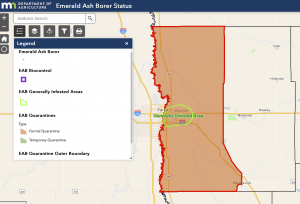Go to Ellen Hopkins Elementary in Moorhead, Minn. Walk through the main doors, take a right and head down the hall. Stop at room 160, marked with a nameplate reading “Senora Rieniets.”
This is an elementary school classroom. Inside, you’ll find the usual things: bright colors, warm faces, and young minds. One thing you may be surprised to find, though, is the presence of three different age groups: third, fourth and fifth grade students.
That’s because recent cuts have forced Ellen Hopkins Elementary to “roll together” age groups in their Spanish Immersion program. The program may not be the only thing affected by budgetary concerns at Hopkins Elementary.
It was announced in the end of January that the state of Minnesota will be delaying $423 million—about $2 million from Moorhead—of state aid that is due to schools in order to balance the state budget. This delay is on top of another $1.8 billion in school payments Gov. Tim Pawlenty ordered to be delayed over the next two years, also being used to balance the state budget.
The decision is bad news for the Moorhead Public School District. In November, the district saw its bid for an operating levy defeated by its taxpayers. According to Lynne Kovash, superintendent of schools, the state of Minnesota would normally send the funds in monthly increments in March, April and May.
Now, as the state deals with what Kovash calls “cash-flow problems,” the state can delay payment until May, when Moorhead and other schools will receive their full payments. The district is forced to dip into its fund balance, which Kovash likens to a savings account. It is there in case of emergencies such as these, but when you take money from it, you lose a lot in interest. It is estimated by Kovash that as much as 75 percent of the fund balance could be used.
With the fund balance in place, the shift in payments becomes a larger concern, according to Kovash. With the district getting less this year from the state, and taxpayers refusing to give more, the Moorhead schools were forced to borrow $5 million dollars.
The Spanish Immersion program is only one at-risk program. It offers the opportunity for students, enrolled in the program by their parents, to learn in a second language. It is unlike most Spanish programs in that students don’t merely learn the language, but they also learn the regular curriculum, including reading, math, and science, in Spanish, according to Mary Jo Schmid, principal of Ellen Hopkins Elementary.
The combined classes—forced by lack of funding—alter the curriculum greatly, Schmid said. Jessica Rieniets, along with other Spanish Immersion teachers, has to create curricula to span five semesters which will challenge each student in their class. Besides the increase in age diversity in the classes, the average teacher now has almost 30 students, compared to the 20 they had before the school had to limit spending in the program.
The need to save money has led to reductions in electricity and heat use, says Schmid, but also has more dire effects. Due to cuts, Ellen Hopkins Elementary recently had to terminate three teachers. Kovash also says that district teachers have recently been forced to take a salary freeze due to the lack of funds.
Each year, principals like Schmid get what is called a full-time equivalency. The FTE number represents the number of full-time workers she is able to employ at the school. According to Schmid, her FTE has been getting smaller for years, which means larger class sizes by as many as five students per teacher, increasing the average class from 25 to 30 students. As the number of students increases, the individual attention each gets will suffer, which can have negative consequences.
“We have seen an escalation of behaviors,” Schmid said. “Students will act out to get that attention that they need.”
Spending on important supplies and equipment, such as pencils, chalk, and even computers, has also been cut, according to Schmid. The Parent-Teacher Organization usually uses their funds to pay for functions such as field trips, but Schmid recently had to ask the organization to use the money to pay for new computers, so there won’t be any field trips for students this year.
Kovash noted that cutting programming is especially hard, because of her desire to create a variety of options for students. She also said that while most taxpayers point to extra curricular activities as easy to cut, there are several problems with doing so. She fears that if fees are charged, only students with the financial means to join activities will do so.
“For some students, that’s what keeps them coming to school,” Kovash said. “I’d be worried about whether [charging for activities] would raise our dropout rates.”
With the decrease in funding, Schmid is worried the schools may also have to settle for less skilled educators, as the more talented and experienced workers go to other states or private schools. According to Schmid, the most important thing is the experience of the student, and those good teachers are desperately needed.
“The quality of a child’s experience as a student is mostly reliant on the quality of the teacher,” she said. “My worry is that with the arrival of talented educators, will we be able to retain them? Or will they go somewhere else?”
While there isn’t much the school can do when denied funds by both state and local taxpayers, Schmid says a difference can be made outside of the school.
“The parents’ involvement needs to be even higher during this kind of time,” Schmid said. “Parents can no longer believe the teacher can do it all. Reinforcement needs to begin at home.”
Although the district does not expect to have to make any cuts due to this delay, Kovash says they must be prepared to face such circumstances.
“We have to be innovative and do things differently,” Kovash said. “We’re going to have to use processes to determine what to give up, because we probably won’t have funding for the next seven to 10 years.”
Part of the problem with making budget cuts, Kovash said, is state mandates on graduation requirements and educator training. If the state removed or at least reduced some of the mandates, such as professional development workshops for teachers, cuts could be made in those areas. Kovash says the best way to go about this would be to stop the mandating and allow districts to determine for themselves what is important.
“We owe it to our students to find the best ways to offer them an education,” Kovash said.
Schmid hopes the government will soon move their focus away from the present and more toward the future.
“The push is to protect the taxpayer of right now,” Schmid said. “But if we don’t do enough to create a strong citizenry for later, they won’t be able to function.”
Education, Schmid says, is crucial to our country’s global competitiveness of tomorrow.
“We have to invest in the future,” Schmid said. “Education is the powerful piece of the puzzle that will not only pull people together, but will pull us out of poverty.”
Kovash agreed, saying that public education is crucial to our future, and Minnesotans must remain optimistic it will remain viable.
“We may have to give up many things in the future of our community, but we can’t give up public education,” she said. “We can’t close our doors. We need to find a way to keep it open and keep it working. Our students deserve that.”






Be First to Comment